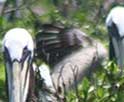Kilimanjaro's Giant Senecio: Prehistoric Plants of the Mountain
Dendrosenecio Kilimanjari: Exploring Kilimanjaro's Strange Flora
Reading time : 1 minute,
Discovery Chepe Id-694-ECO
Published in
05-09-2025

Photos: MissFacto "X".
High up in the alpine zones of Africa's tallest mountains live some of the planet's most fascinating and bizarre plants: the giant senecios. Found primarily on Mount Kilimanjaro, Mount Kenya, and the Rwenzori Mountains, these towering botanical oddities look like they belong in a prehistoric world or perhaps on another planet.
What Are Giant Senecios?
Giant senecios belong to the genus Dendrosenecio, a group of plants that evolved from the common daisy family. Over time, they adapted to the harsh conditions of Africa's high-altitude environments. Despite their alien appearance, these plants are part of the Asteraceae family, the same as your garden daisies.
Strange and Impressive Appearance
With thick, woody trunks and huge rosettes of green leaves at their tops, senecios can grow over 6 meters tall. They often appear as natural sculptures rising out of mist and volcanic rock.
Height: These plants can reach up to 6-7 meters tall, making them look like trees, though they're technically giant herbs.
Structure: They have a central trunk covered in layers of old, dead leaves that insulate them against extreme cold.
Foliage: The green, waxy leaves form a rosette that can close at night to protect the plant from freezing.

Prehistoric Plants on Kilimanjaro: The Amazing Giant Senecio
Photos: MissFacto "X".
Evolutionary Adaptation
The environment of the high mountains is unique: blistering sun by day, freezing temperatures by night. The senecios' insulation system and ability to conserve water help them survive these extremes. Their trunks act as thermal batteries, and their old leaves form a kind of natural coat. It's a stunning example of evolution in isolation.
Why Do They Look Prehistoric?
These plants resemble no other living vegetation in the region. Their size, symmetry, and rugged features evoke the landscapes of Earth's distant past. While they are not from the time of the dinosaurs, their ancient-looking form gives them an undeniably prehistoric vibe. Many explorers have compared them to the setting of a fantasy film.
Where Can You See Them?
If you hike to the alpine or moorland zones of Kilimanjaro, especially along the Machame Route, you'll come across entire valleys filled with these strange trees. They're also prominent on Mount Kenya and in Uganda's Rwenzori Mountains.
Scientific Importance
Botanists and ecologists are fascinated by the senecios for their rapid and specialized evolution. The genus Dendrosenecio only developed in the last million years' a blink in geological time. Yet in that short span, they evolved highly unique forms to cope with extreme habitats.
Preservation and Threats
As climate change alters high-altitude ecosystems, these plants are under threat. Warmer temperatures and shifting weather patterns could destabilize the environments they depend on. Conservationists are working to study and protect them as symbols of alpine biodiversity.
The giant senecios of Kilimanjaro are more than just oddities of nature. They are living monuments to adaptation, and a breathtaking sight for anyone lucky enough to hike among them. Their story is a powerful reminder of nature's creativity and resilience.
A tour of these gigantic prehistoric forest pic.twitter.com/YdLEfj3deU
— MissFacto (@missfacto) June 16, 2024
See Also
Discovery Chepe
Most read...















